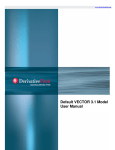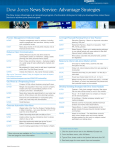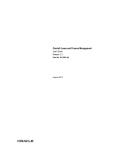Download User Guide
Transcript
Markit iBoxx USD Emerging
Markets Sovereigns Index
October 2014
Markit iBoxx USD Emerging Markets Sovereigns Index
Index Guide
Table of Contents
1
2
3
4
5
Markit iBoxx USD Emerging Markets Sovereigns Index .................................................................................. 5
1.1
Index Governance........................................................................................................................................... 5
1.1.1
Technical Committee .............................................................................................................................. 5
1.1.2
Oversight Committee .............................................................................................................................. 5
1.2
Publication of the Markit iBoxx USD Emerging Market Sovereigns Index ..................................................... 5
Bond Selection Rules .......................................................................................................................................... 6
2.1
Bond Type ....................................................................................................................................................... 6
2.2
Issuer Type ..................................................................................................................................................... 6
2.3
Issuer Domicile ............................................................................................................................................... 6
2.4
Amount Outstanding and Denomination ......................................................................................................... 6
2.5
Time to Maturity .............................................................................................................................................. 6
2.6
Age .................................................................................................................................................................. 6
2.7
Credit Rating ................................................................................................................................................... 6
2.8
International Tradability .................................................................................................................................. 7
2.9
Emerging Market Definition ............................................................................................................................ 7
2.9.1
Issuer domicile ............................................................................................................................................ 7
2.9.2
Defaulted countries and sovereign debt rating ........................................................................................... 7
2.9.3
Additional restriction for countries on financial sanction regimes ............................................................... 7
Bond Classification .............................................................................................................................................. 8
3.1
Overall Bond Classification Scheme............................................................................................................... 8
3.2
Sovereigns ...................................................................................................................................................... 8
Index Calculation ................................................................................................................................................. 9
4.1
Static Data ...................................................................................................................................................... 9
4.2
Bond Prices ..................................................................................................................................................... 9
4.3
Rebalancing Process ...................................................................................................................................... 9
4.4
Index Data ....................................................................................................................................................... 9
4.5
Index Calculus ................................................................................................................................................ 9
4.6
Treatment of special intra-month events ...................................................................................................... 10
4.6.1
Index and Analytics Weightings ................................................................................................................ 10
4.6.2
Funged Bonds ........................................................................................................................................... 10
4.6.3
Unscheduled full redemption – buybacks ................................................................................................. 10
4.6.4
Bonds trading flat of accrued .................................................................................................................... 11
4.6.5
Multi-coupon bonds................................................................................................................................... 11
4.6.6
Ex-dividend conventions ........................................................................................................................... 11
4.7
Index History ................................................................................................................................................. 11
4.8
Settlement conventions ................................................................................................................................ 11
4.9
Calendar ....................................................................................................................................................... 11
4.10 Data Publication and Access ........................................................................................................................ 11
4.11 Index Restatement ........................................................................................................................................ 12
4.12 Index Review ................................................................................................................................................ 12
Further Information ............................................................................................................................................ 13
Copyright © 2014, Markit Group Limited. All rights reserved. www.markit.com
Markit iBoxx USD Emerging Markets Sovereigns Index
Index Guide
Copyright © 2014, Markit Group Limited. All rights reserved. www.markit.com
Markit iBoxx USD Emerging Markets Sovereigns Index
Index Guide
Changes to the iBoxx USD Emerging Markets Sovereigns Index
01 Oct 2014
31 Mar 2013
30 Nov 2012
31 Oct 2010
Index restatement, complaints sections added,
Additional clarifications on bond eligibility, classification and corporate actions
Markit iBoxx USD Emerging Markets Sovereigns Index will be based on additional prices
sources as described in the document ‘Markit iBoxx Pricing Rules’
Change of emerging markets definition to Markit Global Economic Development Classification
Methodology
Launch of iBoxx USD Emerging Markets Sovereigns Index
Copyright © 2014, Markit Group Limited. All rights reserved. www.markit.com
Markit iBoxx USD Emerging Markets Sovereigns Index
Index Guide
1 Markit iBoxx USD Emerging Markets Sovereigns Index
The Markit iBoxx USD Emerging Markets Sovereigns Index is designed to reflect the performance of USD
denominated sovereign bonds issued by entities domiciled in the emerging markets. The index rules aim to offer a
broad coverage of the emerging market sovereign bond universe, whilst upholding minimum standards of
investability and liquidity. As of January 2013, the index tracks more than USD 450 bn worth of debt covering 54
individual countries/territories in Africa, Asia, Europe, Latin America and the Middle East. The indices are an integral
part of the global Markit iBoxx index families, which provide the marketplace with accurate and objective indices by
which to assess the performance of bond markets and investments
All iBoxx indices are priced based on multiple data inputs. The Markit iBoxx USD Emerging Markets Sovereigns
Index uses multi-source prices as described in the document “Markit iBoxx Pricing Rules” publically available on
www.markit.com/indices. Additionally, the index rules and their application will be governed by two Index Advisory
Committees:
Technical Committee: consists of representatives from market makers / banks and meets on a monthly basis in
order to provide feedback and information into the monthly rebalancing process and to monitor any market
developments.
Oversight Committee: consists of representatives from mostly the buy side and meets in order to discuss the
decisions of the Technical Committee, the wider index rules and any market developments which may warrant
rule changes.
This document covers the index rules and calculation methodology.
1.1 Index Governance
In order to ensure the independence and the objectivity of the Markit iBoxx USD Emerging Market Sovereigns Index,
Markit will seek the advice from two distinct Index Advisory Committees. This is in line with the index advisory
structure for the main Markit iBoxx index families.
1.1.1 Technical Committee
The Technical Committee consists of representatives of market makers/banks. The main purpose of this group is to
provide assistance in the identification of eligible constituents, especially in the instance where the eligibility or the
classification of a bond is unclear or contentious. Additionally, the Technical Committee discusses any market
developments which may warrant index rule changes, and provide recommendations on changes to the rules or
additional indices. It also reviews the impact of financial sanctions on the eligibility of countries or specific index
constituents. The Technical Committee meets once a month.
1.1.2 Oversight Committee
The Oversight Committee consists of representatives from a broad range of asset managers, consultants and
industry bodies. The purpose of this committee is to review the recommendations made by the Technical Committee
and also to provide consultation on any market developments which may warrant rule changes.
1.2 Publication of the Markit iBoxx USD Emerging Market Sovereigns Index
The index is calculated at the end of each business day and re-balanced at the end of each month. The indices are
calculated on the basis of end-of-day iBoxx prices on each trading day defined in the iBoxx USD Index calculation
calendar. The index calculation calendar is available in the indices section on www.markit.com/indices under
Calendar for data subscribers. Index data and bond price information is also available from the main information
vendors.
Bond and index analytical values are calculated each trading day using the daily closing prices. Closing index values
and key statistics are published at the end of each business day in the indices section on www.markit.com/indices for
registered users. In addition, midday fixing levels for bond prices and indices are also published.
Copyright © 2014, Markit Group Limited. All rights reserved. www.markit.com
Markit iBoxx USD Emerging Markets Sovereigns Index
Index Guide
2 Bond Selection Rules
The eligible universe is derived from emerging market central government debt denominated in US dollars.
The following selection criteria are used to determine the index constituents:
Bond type
Issuer type
Issuer domicile
Amount outstanding and Denomination
Time to maturity
Age
Credit Rating
International Tradability
2.1 Bond Type
In particular, the following bond types are eligible:
Plain vanilla fixed coupon bonds
Zero coupon and multi coupon bonds with fixed coupon schedules
Sinking fund and capitalizing bonds with a fixed sinking/capitalizing schedule
The following bond types are excluded from the indices:
Callable bonds
Putable bonds
For retail bonds and private placements, publicly available information is not always conclusive and the classification
of a bond as a retail bond or a private placement will be made at Markit’s discretion based on the information
available at the time of determination. Markit may consult with the specific Index Advisory Committees to review
potential retail bonds or private placements. Any bond classified as retail or private placement is added to the list of
excluded private placements and retail bonds. The list is published on www.markit.com/indices under Indices News
for future reference and to ensure decision’s consistency.
In instances where a new bond type is not specifically excluded or included according to the published index rules,
Markit will analyse the features of such securities in line with the principles set out in 2.1 of this guide. Markit may
consult the specific Index Advisory Committees. Any decision as to the eligibility or ineligibility of a new bond type will
be published and the index rules will be updated accordingly.
The inclusion rules are reviewed regularly (once a year) and may be changed to capture new market trends if
previously excluded bond types start to account for a significant share of a country’s or region’s bond issuance.
2.2 Issuer Type
Only sovereign debt issued by the central government or the central bank is eligible for the indices. Restructured
debt is eligible for the indices, but Brady bonds are not.
2.3 Issuer Domicile
Only debt from the emerging markets as defined in chapter 2.9 is considered.
2.4 Amount Outstanding and Denomination
The bonds need to be denominated in US dollar and need to have a minimum amount outstanding of USD 500 m.
2.5 Time to Maturity
At inclusion in the index, bonds need to comply with a minimum time to maturity rule. The minimum time to maturity
is 1 year, in line with other iBoxx bond indices. The minimum life at issuance measured from the first settlement date
to the maturity date of the bond must be 18 months or more.
2.6 Age
There is no age restriction.
2.7 Credit Rating
The minimum average rating for bonds to be considered eligible is CCC.
Copyright © 2014, Markit Group Limited. All rights reserved. www.markit.com
Markit iBoxx USD Emerging Markets Sovereigns Index
Index Guide
2.8 International Tradability
Bonds should be internationally tradable. ISINs are used as a proxy to determine the tradability. Only ISINs
originating from Japan, the US or Western Europe are eligible for the indices. The initial list only contains bonds with
American ISINs (starting with “US”), German ISINs (starting with “DE” in the EUR index) or international ISINs
(Luxembourg – starting with “XS”), ISINs from other Western European countries are also eligible but currently not in
issue.
2.9 Emerging Market Definition
2.9.1 Issuer domicile
Only issuers from countries/territories classified as emerging markets are eligible for the indices. The list of emerging
markets is established according to Markit Global Economic Development Classification Methodology and is used to
determine the eligibility of the issuer. The classification methodology as well as the up-to-date classifications are
published in the indices section on www.markit.com/indices under Markit Bond Indices / Markit iBoxx / Markit iBoxx
Rules. The classifications are updated annually and implemented on 30 November each year.
2.9.2 Defaulted countries and sovereign debt rating
Countries that are in default on their external debt or that do not have a long term foreign debt rating from at least
Fitch, Moody’s or S&P are excluded from the indices. Countries with ratings of D or RD from Fitch, C or Ca from
Moody’s and D or SD from S&P are not eligible. A default is determined based on information from the rating
agencies.
In addition, a country is considered to be in default if one of the 6 credit events as defined by ISDA occurs:
Bankruptcy
Obligation Acceleration
Obligation Default
Failure to Pay
Repudiation/Moratorium
Restructuring
2.9.3 Additional restriction for countries on financial sanction regimes
Countries included on the financial sanctions’ lists of the European Union or the US are excluded from the indices
unless:
Sanctions are applied to specific individuals only, or
Funds, funding and financial transactions of the government and government-related entities are unaffected by
the sanctions.
The information about the sanctions regime is compiled:
For the European Union from the Common Foreign & Security Policy from
http://ec.europa.eu/external_relations/cfsp/sanctions/measures.htm
For the US from the Office of Assert Control (OFAC) from http://www.treas.gov/offices/enforcement/ofac/
A country is placed on the sanction list if relevant sanctions apply for either the European Union or the US. The
decision about adding/removing countries is taken in consultation with the Technical Committee. Any decision to
change the list of countries on the sanction list is immediately published on the web.
A country emerging from default is re-included in the index at the next index rebalancing after its rating has been
reinstated. If financial sanctions are instated for a particular country, this country is removed from the index at the
next month-end. If financial sanctions are lifted, the country is included in the index at the next index re-balancing
after all relevant sanctions have been lifted.
Based on current information, the following countries are excluded from the indices because of applicable sanctions:
Cuba
Iran
Myanmar
North Korea
Sudan
Syria
Copyright © 2014, Markit Group Limited. All rights reserved. www.markit.com
Markit iBoxx USD Emerging Markets Sovereigns Index
Index Guide
3 Bond Classification
All bonds are classified based on the principal activities of the issuer and the main sources of the cash flows used to
pay coupons and redemptions.
The issuer classification is reviewed regularly based on updated information received by Markit, and status changes
are included in the indices at the next rebalancing if necessary.
Where the sector classification of a specific entity is not very clear due to the diversified business of the entity,
decision will be made at Markit’s discretion. Markit will assign the Markit classification according to its evaluation of
the business risk presented in the security prospectus and annual reports, if available. Markit will also compare the
classification to peers in the potential sectors, and Markit may consult with the Index Advisory Committees.
Membership list including classification is published on the FTP server and in the indices section on
www.markit.com/indices for registered users for future reference and to ensure decision’s consistency.
3.1 Overall Bond Classification Scheme
The following classification scheme is used for the bonds:
Level 0
Index family, i.e. USD
Level 1
Country of risk
Level 2
External Debt
Level 3
Sovereigns
Level 4
Region (Asia, EEMEA, Latin America)
3.2 Sovereigns
Bonds issued by a central government and denominated in USD.
Copyright © 2014, Markit Group Limited. All rights reserved. www.markit.com
Markit iBoxx USD Emerging Markets Sovereigns Index
Index Guide
4 Index Calculation
The index is market capitalization weighted.
4.1 Static Data
Information used in the index calculation is sourced from offering circulars and checked against standard data
providers.
4.2 Bond Prices
For more details please refer to the “Markit iBoxx Pricing Rules” document, available on the Markit iBoxx Rules page
of
www.markit.com
(http://www.markit.com/en/products/data/indices/bond-indices/iboxx/rules.page)
in
the
Methodology Documentation section on the right-hand side of the page.
4.3 Rebalancing Process
All Markit iBoxx USD indices are rebalanced monthly on the first business day of the month. Changes to amounts
outstanding are only taken into account if they are publicly known three business days before the end of the month.
Changes in ratings are only taken into account if they are publicly known three business days before the end of the
month. Any changes after the index cut-off day (t-3) will not be considered in the re-balancing process, but will
become effective at the end of the following month. New bonds issued are taken into account if they are publicly
known to settle until the last calendar day of the month, inclusive, and if their rating and amount outstanding has
become known at least three trading days before the end of the month.
Four business days before the end of each month a preliminary membership list is published on
http://indices.markit.com. This list contains preliminary information on rating and uncapped amount outstanding of
the bonds.
Three business days before the end of each month, a membership list ("Constituents Super List") with the full
amount outstanding for each bond is published. This Constituents Super List contains the maximum number of
constituents for the next month.
Two business days before the end of the month, the rating information for the bonds on the Constituents Super List
is updated and the list is adjusted for all new rating changes that have occurred three business days prior to monthend. The weight of each country and the notional amount for each bond is calculated. The resulting list is the final
membership list for the following month and is published as soon as all rating changes are confirmed.
On the last business day of each month, Markit publishes the final membership with closing prices for the bonds, and
various bonds analytics based on the index prices of the bonds.
4.4 Index Data
A sub-index is calculated if at least one bond matches all inclusion criteria. If no more bonds qualify for an index,
then its level remains constant. If at least one bond becomes available again, the index calculation resumes and is
chained to the last calculated level.
All bonds are assigned to sub-indices according to their classification. The assignment of a bond to a certain maturity
bucket is based on its expected remaining life. All bonds remain in their maturity bucket for the entire month.
The calculation of the indices is based on bid prices. New bonds are included in the indices at their respective ask
prices when they enter the index family. In the event that no price can be established for a particular bond, the index
continues to be calculated based on the last-available price. This might be the case in periods of market stress, or
disruption as well as in illiquid or fragmented markets. If the required inputs become impossible to obtain, Markit may
consult the specific Index Advisory Committees at the following rebalancing date. To ensure consistency, decisions
taken are made publicly available on a timely basis and Markit has the ability to refer back to previous cases.
On the last trading day of a month, the rebalancing takes place after the daily index calculation for the current
month’s list, including the calculation of the last calendar day’s indices, has been performed.
4.5 Index Calculus
For specific index formulae please refer to Markit iBoxx Bond Calculus document, available on the Markit iBoxx
Rules page of www.markit.com (http://www.markit.com/en/products/data/indices/bond-indices/iboxx/rules.page) in
the Methodology Documentation section on the right-hand side of the page.
Copyright © 2014, Markit Group Limited. All rights reserved. www.markit.com
Markit iBoxx USD Emerging Markets Sovereigns Index
Index Guide
4.6 Treatment of special intra-month events
Data for the application of corporate actions in the indices may not be fully or timely available at all times, e.g. the
final call prices for make-whole calls or the actual pay-in-kind percentage for PIK-payment options. In such cases,
Markit will estimate the approximate value based on the available data at the time of calculation.
4.6.1 Index and Analytics Weightings
All iBoxx USD Indices are volume-weighted indices, with the bond’s amount outstanding as the weighting factor. The
amount outstanding of a bond is only adjusted at the monthly re-balancing process at the end of each month.
However, scheduled redemption payments for amortising bonds and sinking funds are taken into account from the
date they occur, as they have a significant influence on index return and analytical values. In addition, bonds that are
fully redeemed intra-month are also taken into account immediately. Therefore, the indices are based on adjusted
amount outstanding, derived from the amount issued and closely related to the amount outstanding of a bond. The
concept is summarised below.
Definitions:
Amortising bonds: Bonds whose face value is redeemed according to a schedule at more than one redemption
date. Interest payments are made on the basis of the remaining value of the bond.
Sinking funds: Bonds, for which money is applied periodically to redeem part of the outstanding before maturity.
At the redemption dates the appropriate amount of bonds may either be retired randomly from the outstanding
bonds, or purchased on the open market and thus retired. Interest payments are made on the remaining
outstanding bonds.
Fully redeemed bonds: Bonds that are completely repurchased prior to or at the calculation date.
The amount issued of a bond does not change when coupons are paid and bonds are redeemed. However,
additional tranches and unscheduled repurchases have to be taken into account to arrive at a suitable basis for index
and analytics calculations. Therefore the adjusted amount outstanding is the common basis on which all calculations
are based.
In addition, incoming bond prices from price providers are linked to the amount outstanding, rather than to the
amount issued. This ensures a common basis (to the nominal value of 100), on which all bonds are priced and the
indices are calculated.
4.6.2 Funged Bonds
Bonds may be issued in several tranches. The different tranches are initially legally separate and therefore trade
independently for a certain period. On and after the funge date, the tranches will be combined into one bond, i.e. the
parent tranche will contain the original security, as well as the additional notional(s) from the new tranche(s). After
the funge date, the prices for both the securities are the same, because they constitute one uniform bond. This is
reflected in the indices as follows:
4.6.2.1
Parent and new tranche are both index constituents
After the funge date, the price from the parent tranche is used for the funged tranche; no price for the funged
bond.
Funged tranche leaves the index at the next rebalancing and parent amount outstanding increases accordingly.
4.6.2.2
Parent is an index constituent, but the new tranche is not
No special intra-month treatment necessary
Parent amount outstanding increases at the next rebalancing
4.6.2.3
Parent is not an index constituent but the new tranche is
No special intra-month treatment necessary
Funged tranche leaves the index; parent tranche enters the index at the next rebalancing
4.6.3 Unscheduled full redemption – buybacks
If a bond is fully redeemed intra-month, the bond effectively ceases to exist. In all calculations, the redeemed bond is
treated as cash based on the last price or repurchase price, as applicable. The redemption factor Fi,t, Redemption
Ri,t and the Redemption Price RPi,t are used to treat these events in the index and analytics calculation. In addition,
the clean price of the bond is set to the redemption price, and the interest accrued until the redemption date is
treated as an irregular coupon payment.
Copyright © 2014, Markit Group Limited. All rights reserved. www.markit.com
Markit iBoxx USD Emerging Markets Sovereigns Index
Index Guide
4.6.4 Bonds trading flat of accrued
If a bond is identified as trading flat of accrued, the accrued interest of the bonds is set to 0 in the total return index
calculation and the bond is excluded from the calculation of all bond and index analytical values.
4.6.5 Multi-coupon bonds
Some bonds have pre-defined coupon changes that lead to a change in the annual coupon over the life of the bond.
In all instances, the coupon change must be a fixed amount on top of a fixed coupon, i.e. floating coupon bonds are
not eligible for the indices. The two main categories of bonds are step-up bonds and event-driven bonds.
Step-up bonds: These are bonds with a pre-defined coupon schedule that cannot change during the life of the
bond. The coupon schedule is used in all bond calculations.
Event-driven bonds: These are bonds whose coupon may change upon occurrence (or non-occurrence) of prespecified events, such as rating changes, e.g. rating-driven bonds, failure to register a bond, e.g. register-driven
bonds, or failure to complete a merger, e.g. merger-driven bonds. In the calculation of the indices and the
analytics, the coupon schedule as of the calculation date is used. That is to say, any events occurring after the
calculation date are ignored in the determination of the applicable coupon schedule.
Example of an event-driven bond: A bond’s rating changes on 31 December 2003 from A- to BBB+, and the
coupon steps up from 6% to 6.25% from 01 March 2004 onwards. The coupon dates are 01 October and 01 April
each year. The correct coupon schedule for the bond and index calculations is date dependent. The index
calculation on 20 December 2003 uses the 6% coupon for the whole life of the bond, while the calculation on 31
January 2004 uses a 6% coupon for the current coupon period to 29 February 2004, and a 6.25% coupon for all
later interest payments. The index calculation on 20 March uses a 6% coupon until 29 February, a 6.25 % coupon
for the remainder of the current coupon period and a 6.25 % coupon for all future coupon payments. The index
calculation after 01 April uses a 6.25% coupon.
4.6.6 Ex-dividend conventions
Some markets have ex-dividend conventions. Ex-dividend means that the next coupon is detached from the bond
several days in advance of the coupon payment date. The date on which the next coupon is detached is the exdividend date and the period between the ex-dividend date and the coupon payment date is the ex-dividend period. If
a bond is in the ex-dividend period, the next coupon payment will not be paid to a buyer of this bond, but will be paid
to the original bond holder.
The indices and analytics calculations take ex-dividend conventions into account. During the ex-dividend period, the
accrued interest of the bond is negative, while the next coupon payment is held separate in the variable coupon
adjustment CPi,t. If the bond enters the index during the ex-dividend period, then the next coupon payment (and the
coupon adjustment) will not accrue to the index, however, if the bond was already in the index, the next coupon
payment needs to be included in the total return calculations. This is controlled via the ex-dividend indicator XDi,t
which is 0 if the bond enters the index during the current ex-dividend period and 1 if not. The same treatment is also
applied to all analytics calculation, i.e. the first cash flow is excluded from the calculations if the bond enters during
the current ex-dividend period.
4.7 Index History
The index history starts on 31 October 2010. All indices have a base value of 100 on that date.
4.8 Settlement conventions
All Markit iBoxx indices are calculated using the assumption of t+0 settlement days.
4.9 Calendar
Markit publishes an index calculation calendar which is available in the indices section on www.markit.com/indices
under Calendar for data subscribers. This calendar provides an overview of the index calculation times of the Markit
iBoxx bond index families in a given year.
4.10 Data Publication and Access
The Index data is available on http://indices.markit.com, ftp://indices.markit.com, Bloomberg and Reuters. Below are
the access codes for the different vendors and IDs of the Index:
Copyright © 2014, Markit Group Limited. All rights reserved. www.markit.com
Markit iBoxx USD Emerging Markets Sovereigns Index
Index Guide
Table 1: Index Vendor Codes and IDs
Name
Version
Markit iBoxx USD Emerging
Markets Sovereigns
Markit iBoxx USD Emerging
Markets Sovereigns
Total Return
Index
Clean Price
Index
ISIN
Bloomberg
Code
RIC
GB00B4QS0V64
IBOXUSEM
. IBXXUSEM
GB00B4NQ2F14
IBOXUSET
.IBXXUSET
4.11 Index Restatement
Index restatement follows the policy described in the Index restatement policy document, available on the Markit
iBoxx Rules page of www.markit.com (http://www.markit.com/en/products/data/indices/bondindices/iboxx/rules.page)
in the Methodology Documentation section.
4.12 Index Review
Index methodology reviews for the indices outlined within this guide are performed on a periodic basis. Any material
changes to the methodology governing the indices are published on the Markit website.
Copyright © 2014, Markit Group Limited. All rights reserved. www.markit.com
Markit iBoxx USD Emerging Markets Sovereigns Index
Index Guide
5 Further Information
Glossary of key terms is available in the Glossary document, available on the Markit iBoxx Rules page of
www.markit.com
(http://www.markit.com/en/products/data/indices/bond-indices/iboxx/rules.page)
in
the
Methodology Documentation section
For contractual or content issues please refer to
Markit Indices Limited
Walter-von-Cronberg-Platz 6
60594 Frankfurt am Main
Germany
Tel
Fax
+49 (0) 69 299 868 100
+49 (0) 69 299 868 149
E-mail
internet:
[email protected]
indices.markit.com
For technical issues and client support please contact [email protected] or
Asia Pacific
Europe
USA
Japan: +81 3 6402 0127
General: +800 6275 4800
+1 877 762 7548
Singapore: +65 6499 0079
UK: +44 20 7260 2111
Formal complaints can be sent electronically to a specifically dedicated email address –
[email protected]. Please note [email protected] should only be used to log formal
complaints. For any general index enquiries, please contact Markit iBoxx indices support group
[email protected]
Licences and Data
iBoxx is a registered trademark of Markit Indices Limited. Markit Indices Limited owns all iBoxx data, database
rights, indices and all intellectual property rights therein. A licence is required from Markit Indices Limited to create
and/or distribute any product that uses, is based upon or refers to any iBoxx index or iBoxx data.
Ownership
Markit Indices Limited is a wholly-owned subsidiary of Markit Group.
Other index products
Markit Indices Limited owns, manages, compiles and publishes the iTraxx credit derivative indices and the
iBoxxFX Trade Weighted Indices.
Copyright © 2014, Markit Group Limited. All rights reserved. www.markit.com























